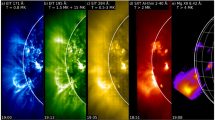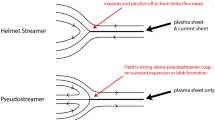Abstract
We have studied the time behavior of the orbital period and the primary’s pulsation period for the eclipsing binary system Y Cam, whose secondary fills its Roche lobe and whose primary is a δ Scuti star. The times of minima available for this eclipsing binary cover 120 years. δ Scuti pulsations of the primary have been observed over the last 50 years, with the period of these pulsational brightness variations remaining virtually unchanged during the entire observed time interval. The large-amplitude cyclic variations of the orbital period of Y Cam cannot be explained solely by the presence of a third body in the system. It is possible to explain the period variations of Y Cam with magnetic oscillations or a superposition of a stationary matter flow from the lower-mass to the higher-mass component together with magnetic oscillations, similar to the case of AB Cas. A good agreement with observations is provided by a model assuming a stationary matter flow from the secondary filling its Roche lobe to the primary, at the rate of 2.85 × 10−7 M ⊙/year, superposed with irregular period jumps that can be explained by instabilities in the matter flow. We have detected cyclic variations of the orbital period of Y Cam with an amplitude of 0.011d, which can be understood if the binary moves in a long-period orbit (with a period of 38.6 years) around a third body with mass M 3 s> 0.30M ⊙. These cyclic period variations of the eclipsing binary agree with the observed small period variations of the δ Scuti pulsations.
Similar content being viewed by others
References
J. M. Kreiner, Acta Astron. 21, 365 (1971).
J. M. Kreiner and J. Ziolkowski, Acta Astron. 28, 497 (1978).
S. O. Selam and O. Demircan, Turk. J. Phys. 23, 301 (1999).
D. I. Hoffman, T. E. Harrison, B. J. McNamara, et al., Astron. J. 132, 2260 (2006).
P. Zasche, A. Liakos, M. Wolf, and P. Niarchos, New Astron. 13, 405 (2008).
L. V. Mossakovskaya, Perem. Zvezdy 23, 179 (1993).
T. Borkovits and T. Hegedüs, Astron. Astrophys. Suppl. Ser. 120, 63 (1996).
J. H. Applegate, Astrophys. J. 385, 621 (1992).
Kh. F. Khaliullin and A. I. Khaliullina, Mon. Not. R. Astron. Soc. 419, 3393 (2012).
W. Ceraski, Astron. Nachr. 162, 203 (1903).
E. Rodriguez, J. M. Garcia, V. Costa, et al., Mon. Not. R. Astron. Soc. 408, 2149 (2010).
S. Blazko, Astron. Nachr. 177, 119 (1908).
R. S. Dugan, Contrib. Princeton Univ. Observ., No. 6, 1 (1924).
P. Broglia and F. Marin, Astron. Astrophys. 34, 89 (1974).
O. Struve, H. G. Horak, R. Canavaggia, et al., Astrophys. J. 111, 658 (1950).
M. Harwood, Ann. Harvard College Observ. 84, 37 (1933).
A. Szczepanowska, Acta Astron. Ser. B 2, 134 (1955).
M. Plavec, M. Smetanova, and Z. Pekný, Bull. Astron. Inst. Czechosl. 12, 117 (1961).
P. Broglia and P. Conconi, Astron. Astrophys. 138, 443 (1984).
T. Borkovits and T. Hegedüs, Publ. Observ. Astron. Belgrade, No. 49, 97 (1995).
A. I. Khaliullina and Kh. F. Khaliullin, Sov. Astron. 28, 228 (1984).
Kh. F. Khaliullin, Sov. Astron. 18, 229 (1974).
P. Broglia, Inform. Bull. Var. Stars, No. 823, 1 (1973).
S.-L. Kim, J. W. Lee, J.-H. Youn, et al., Astron. Astrophys. 391, 213 (2002).
D. S. Hall, Space Sci. Rev. 50, 219 (1989).
A. F. Lanza, M. Rodono and R. Rosner, Mon. Not. R. Astron. Soc. 296, 893 (1998).
C. A. Watson and T. R. Marsh, Mon. Not. R. Astron. Soc. 405, 1867 (2010).
D. S. Hall and J. A. J. Whelam, Acta Astron. 29, 653 (1979).
U. S. Chaubey, Bull. Astron. Soc. India 21, 597 (1993).
S. Qian, Astron. J. 119, 3064 (2000).
P. Biermann and D. S. Hall, Astron. Astrophys. 27, 249 (1973).
D. S. Hall, Acta Astron. 25, 1 (1975).
J. Zhang and S. Qain, in Ninth Pacific Rim Conference on Stellar Astrophysics, Ed. by S. Qian, K. Leung, L. Zhu, and S. Kwok, ASP Conf. Ser. 451, 67 (2011).
H. Frieboes-Conde and T. J. Herczeg, Astron. Astrophys. Suppl. Ser. 12, 1 (1973).
Author information
Authors and Affiliations
Corresponding author
Additional information
Original Russian Text © Kh.F. Khaliullin, A.I. Khaliullina, 2013, published in Astronomicheskii Zhurnal, 2013, Vol. 90, No. 7, pp. 565–575.
Rights and permissions
About this article
Cite this article
Khaliullin, K.F., Khaliullina, A.I. Orbital-period variations in the eclipsing binary Y Cam. Astron. Rep. 57, 517–526 (2013). https://doi.org/10.1134/S1063772913060024
Received:
Accepted:
Published:
Issue Date:
DOI: https://doi.org/10.1134/S1063772913060024




